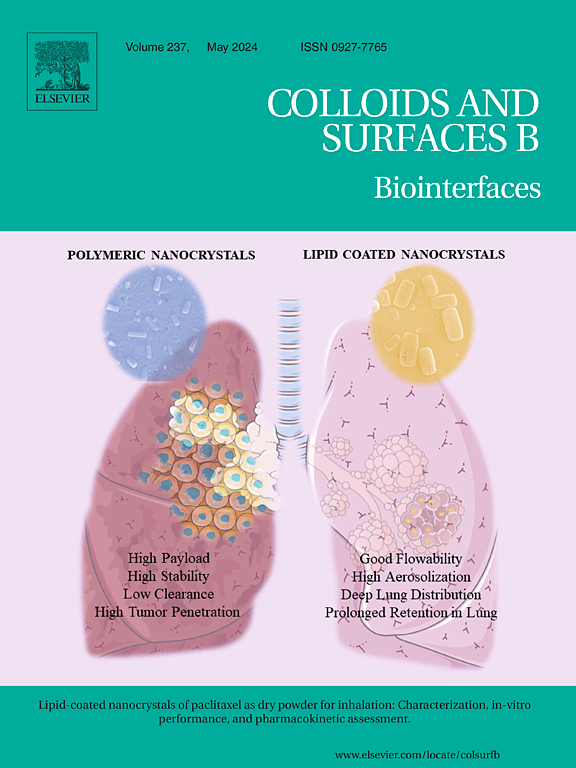Design of enzyme immobilized zwitterionic copolymer nanogels and its size effect on electrochemical reaction
IF 5.4
2区 医学
Q1 BIOPHYSICS
引用次数: 0
Abstract
For enzyme-based electrochemical devices, an improvement in electron transfer between the enzyme and electrode is important. Thus, we developed a nano-scaled hydrogel that includes an electron mediator and enzyme to realize nano-sized effects that enhance the functions. Three different chain lengths (short, medium, and long) of copolymers composed of 2-methacryloyloxyethyl phosphorylcholine (MPC) and methacrylic acid N-hydroxysuccinimide ester (MNHS; poly(MPC-co-MNHS), PMS) were synthesized via reversible addition-fragmentation chain transfer (RAFT) polymerization. The PMS nanogels can bind to the amino ferrocene (AFc) of the electron mediator and glucose oxidase (GOD) as a catalyst. The mono-dispersive PMS nanogels approximately 200–250 nm in size bound with AFc were prepared with different polymer chain lengths and amounts of AFc (PMMFcX_Y%, X= ‘degree of polymerization, 50, 75, 100’ and Y= ‘AFc feeding ratio against the amount of NHS group in the polymer chain, 50 %, 100 %’). The size of PMMFcX_Y% could be controlled by changing degree of polymerization or AFc feeding ratio. After the modification of GOD to PMMFcX_Y%, their size increased slightly from the original size (ca. 200–250 nm) to approximately 250–300 nm. The catalytic activity of nanogel in dispersed system was higher than that of microgel, indicating that nanogels could improve glucose transport in hydrogel layer. Compared to the catalytic reaction of the PMMFc 75_50 %-GOD nanogel-modified electrodes with that of microgel modified electrode, the current response was improved by decreasing the nanogel size, as evaluated by electrochemical measurements. These results revealed that the smaller nanogels could improve both glucose transport and electron transfer via mediator by smaller size, resulting higher efficiency of enzyme immobilized electrode.
酶固定化齐聚物纳米凝胶的设计及其对电化学反应的尺寸影响
对于以酶为基础的电化学装置而言,改善酶与电极之间的电子传递非常重要。因此,我们开发了一种包含电子介质和酶的纳米级水凝胶,以实现增强功能的纳米级效果。我们通过可逆加成-断裂链转移(RAFT)聚合法合成了由 2-甲基丙烯酰氧乙基磷酰胆碱(MPC)和甲基丙烯酸 N-羟基琥珀酰亚胺酯(MNHS;poly(MPC-co-MNHS),PMS)组成的三种不同链长(短、中、长)的共聚物。PMS 纳米凝胶可与作为电子介质的氨基二茂铁(AFc)和作为催化剂的葡萄糖氧化酶(GOD)结合。用不同的聚合物链长度和 AFc 含量(PMMFcX_Y%,X="聚合度,50、75、100",Y="AFc 含量与聚合物链中 NHS 基团含量的比率,50%,100%")制备了与 AFc 结合的单分散 PMS 纳米凝胶,其尺寸约为 200-250 nm。PMMFcX_Y% 的大小可通过改变聚合度或 AFc 进料比来控制。将 GOD 改性为 PMMFcX_Y% 后,其尺寸从原来的约 200-250 纳米略微增加到约 250-300 纳米。纳米凝胶在分散体系中的催化活性高于微凝胶,表明纳米凝胶可以改善葡萄糖在水凝胶层中的运输。与微凝胶修饰电极相比,PMMFc 75_50 %-GOD 纳米凝胶修饰电极的催化反应随着纳米凝胶尺寸的减小而增强。这些结果表明,较小的纳米凝胶可以通过较小的尺寸改善葡萄糖转运和通过介质的电子传递,从而提高酶固定电极的效率。
本文章由计算机程序翻译,如有差异,请以英文原文为准。
求助全文
约1分钟内获得全文
求助全文
来源期刊

Colloids and Surfaces B: Biointerfaces
生物-材料科学:生物材料
CiteScore
11.10
自引率
3.40%
发文量
730
审稿时长
42 days
期刊介绍:
Colloids and Surfaces B: Biointerfaces is an international journal devoted to fundamental and applied research on colloid and interfacial phenomena in relation to systems of biological origin, having particular relevance to the medical, pharmaceutical, biotechnological, food and cosmetic fields.
Submissions that: (1) deal solely with biological phenomena and do not describe the physico-chemical or colloid-chemical background and/or mechanism of the phenomena, and (2) deal solely with colloid/interfacial phenomena and do not have appropriate biological content or relevance, are outside the scope of the journal and will not be considered for publication.
The journal publishes regular research papers, reviews, short communications and invited perspective articles, called BioInterface Perspectives. The BioInterface Perspective provide researchers the opportunity to review their own work, as well as provide insight into the work of others that inspired and influenced the author. Regular articles should have a maximum total length of 6,000 words. In addition, a (combined) maximum of 8 normal-sized figures and/or tables is allowed (so for instance 3 tables and 5 figures). For multiple-panel figures each set of two panels equates to one figure. Short communications should not exceed half of the above. It is required to give on the article cover page a short statistical summary of the article listing the total number of words and tables/figures.
 求助内容:
求助内容: 应助结果提醒方式:
应助结果提醒方式:


